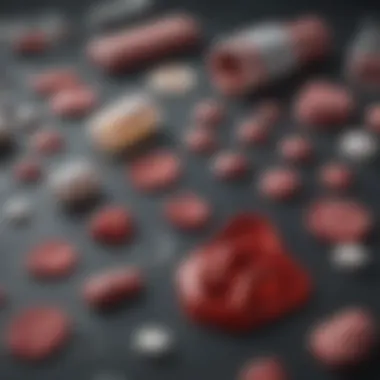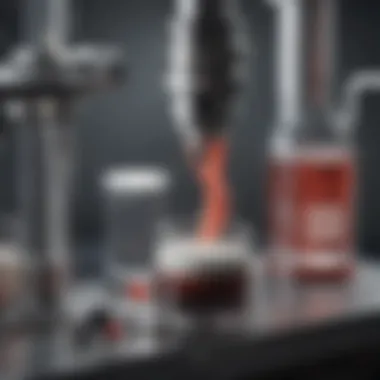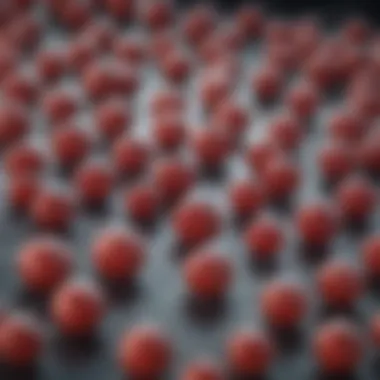Exploring the Dneasy Blood and Tissue Kit


Intro
In the realm of molecular biology and medical diagnostics, the ability to extract high-quality nucleic acids from a variety of biological samples is paramount. The Dneasy Blood and Tissue Kit has emerged as a champion in this field, providing a reliable and efficient tool for researchers and practitioners alike. By enabling the extraction of DNA and RNA, the kit has become an essential asset in laboratories across the globe, from academic research to clinical testing. This article aims to unpack the intricacies, applications, and overall impact of the Dneasy Blood and Tissue Kit, equipping readers with the knowledge they need to harness its full potential.
Research Background
Overview of the scientific problem addressed
The demand for precise nucleic acid extraction has grown tremendously over the years, with applications spanning genetic research, infectious disease diagnostics, and forensic analysis. However, the complexity of biological samples presents multiple challenges. Blood and tissue specimens, in particular, can harbor inhibitors that compromise the integrity of the extracted nucleic acids. The primary scientific challenge lies in developing a methodology that not only neutralizes these inhibitors but does so efficiently and reliably.
Historical context and previous studies
The evolution of nucleic acid extraction methods has been marked by a series of technological advances. Early techniques relied heavily on physical disruption of samples and lengthy purification processes, which proved labor-intensive and time-consuming. Dneasy kits, particularly the Blood and Tissue variant, represent a leap forward in this area. Since their introduction, many researchers have adopted them, citing improvements in yield and purity of nucleic acids extracted from various biological matrices. Studies have shown that the Dneasy approach, which utilizes silica-membrane technology, significantly enhances the extraction process while reducing the risk of contamination.
Findings and Discussion
Key results of the research
The implementation of the Dneasy Blood and Tissue Kit has changed the game for many scientists. Key findings indicate that these kits enable the extraction of nucleic acids with high quality and quantity, suitable for downstream applications like PCR, sequencing, and genotyping. In tests comparing different extraction methods, the Dneasy kit consistently produced higher yields of intact DNA and RNA, even from challenging samples such as formalin-fixed, paraffin-embedded tissues.
Interpretation of the findings
These positive results stem from the kit’s well-thought-out design, which includes lysis buffers specifically formulated to break down cellular components while protecting nucleic acids from degradation during extraction. The kit's protocol is straightforward and user-friendly, reducing the potential for human error, a common pitfall in experimental setups. It simplifies the entire workflow, contributing to increased throughput in laboratory settings.
"The Dneasy Blood and Tissue Kit stands out not merely for its efficiency, but for the reliability it brings to the varied applications in modern bioscience."
With ongoing advancements and research into new applications, it's clear the Dneasy Blood and Tissue Kit will continue to play a crucial role in shaping the landscape of molecular biology and diagnostic testing.
Prolusion to Nucleic Acid Extraction
The process of nucleic acid extraction is foundational in the fields of biology and medicine. It enables researchers to isolate DNA and RNA from various samples, which is essential for a plethora of applications, ranging from genetic research to clinical diagnostics. Understanding the nuances of this extraction process, particularly through kits like the Dneasy Blood and Tissue Kit, can greatly affect the outcomes of research and experimental results. By grasping the significance of nucleic acids and the various extraction techniques employed, researchers can navigate their studies with precision and confidence.
Importance of Nucleic Acids in Research
Nucleic acids, primarily DNA and RNA, are the blueprints of life. Every cell carries genetic information coded within these molecules. Hence, extracting them accurately is crucial in fields such as molecular biology, genetics, and diagnostics.
- Genetic Analysis: Understanding genetic variations and mutations requires high-quality nucleic acids. Researchers rely on this data to develop therapies, study heredity, and conduct evolutionary research.
- Diagnostics: In medical settings, nucleic acid extraction is vital for identifying pathogens through techniques like PCR (polymerase chain reaction). It aids in diagnosing diseases swiftly and accurately.
- Biotechnology: Innovations and developments in biotechnology heavily depend on nucleic acids for producing recombinant proteins or genetically modified organisms. Here, extraction plays a role that can’t be overstated.
To sum it up, nucleic acids serve as the cornerstone of scientific inquiry. Their extraction quality influences research outcomes significantly, making this understanding indispensable for professionals in various domains.
Overview of Extraction Techniques
Extraction techniques for nucleic acids have evolved over the years, catering to the diverse requirements of researchers and clinicians alike. Each method comes with its own set of advantages and challenges, which merits closer examination.
- Phenol-Chloroform Extraction: This traditional method uses organic solvents to separate nucleic acids from aqueous solutions. It’s effective but can be hazardous and requires careful handling.
- Silica-Based Methods: Popular in kits like the Dneasy, these methods utilize silica membranes to bind nucleic acids while impurities are washed away. They’re user-friendly and yield high purity.
- Magnetic Bead-Based Extraction: Increasingly used in modern labs, magnetic beads allow for easy separation of nucleic acids through magnetic fields. It’s a clean and efficient choice, though often more complex.
- Column-Based Extraction: Similar to silica, this method uses columns to separate nucleic acids. It’s quick and has become widespread in commercial kits.
The choice of extraction technique often depends on sample type, desired yield, and purity. Understanding these methods not only informs researchers but also aids in choosing the right strategy for their specific needs.
"Knowledge of nucleic acid extraction is not just technical; it's foundational for advancing research and ensuring result accuracy."
Intro to the Dneasy Blood and Tissue Kit
The Dneasy Blood and Tissue Kit surfaces as a vital instrument in the realm of nucleic acid extraction. In an era where biological research feeds a multitude of applications—from medical diagnostics to forensic science—understanding and appreciating this kit's unique contribution is paramount. Its ease of use, coupled with reliable performance, positions it as a go-to solution for many practitioners in the field. As researchers navigate the complexities of sample types and extraction methods, this comprehensive examination of the Dneasy kit illustrates its importance and versatility, making it a cornerstone in molecular techniques.
History and Development
The journey of the Dneasy Blood and Tissue Kit began in the late 1990s. Developed by Qiagen, it was created in response to a growing demand for effective and reliable nucleic acid extraction methodologies. Researchers were experiencing frustrations with traditional approaches that often yielded subpar results or were prohibitively time-consuming.


Through innovative design and development, the Dneasy kit emerged as a means to streamline the extraction process. Its formulation was guided by the notion that an efficient extraction kit must not only simplify user experience but also enhance yield and integrity of the extracted nucleic acids. Over the years, the kit has undergone numerous refinements, ensuring it remains relevant in an ever-evolving scientific landscape.
Components of the Kit
The Dneasy Blood and Tissue Kit comprises several key components, each meticulously designed to facilitate effective extraction:
- Buffer Solutions: The kit includes specially formulated buffers that optimize cell lysis and subsequent binding of nucleic acids to the provided silica membrane.
- Silica Membrane Columns: At the heart of the extraction process, these columns allow for high-affinity binding of nucleic acids, ensuring clean separation from contaminants.
- Collection Tubes: These tubes are essential for the elution process, holding the purified nucleic acids for downstream applications.
- Enzymatic Solution: Many versions of the kit now also come with enzymes that can breakdown proteins or cellular debris, increasing purity and yield.
Using these components together, the kit simplifies the typically laborious extraction process into manageable steps, reducing hands-on time without compromising the integrity of the results. The robustness of the kit ensures that it can handle a variety of sample types, be it blood, tissue, or cells, making it a pivotal ally in research laboratories.
The Dneasy Blood and Tissue Kit is not just another tool; it stands as a testament to how thoughtful design and user-focused development can lead to breakthroughs in scientific research.
Methodology of the Dneasy Kit
Understanding the methodology behind the Dneasy Blood and Tissue Kit is crucial to harnessing its full potential in nucleic acid extraction. This process is not merely a procedural formality; rather, it is foundational for obtaining high-quality samples that can drive innovative research and diagnostics. By digging into this section, researchers can appreciate the efficiency and scientific rigor of the Dneasy Kit Methodology, which forms the backbone of its application across various fields.
Step-by-Step Extraction Process
To fully grasp how the Dneasy Kit operates, one needs to navigate through its step-by-step extraction process. Here’s a closer look at the crucial stages:
- Sample Preparation: First off, the biological samples need to be collected and prepared. Different samples can be used, from blood to tissue. In this phase, it is imperative to maintain appropriate conditions to preserve the integrity of nucleic acids.
- Lysis of Cells: The heart of the extraction begins here. The lysis buffer breaks open cell membranes, releasing nucleic acids into the solution. Key reagents in the buffer help to denature proteins and other cellular components, ensuring that any contaminants are minimized.
- Binding of Nucleic Acids: This step involves adding alcohol to the lysate, which facilitates the binding of nucleic acids to a silica membrane within the spin column. The interaction of nucleic acids with the membrane is fundamental in separating them from other cellular debris.
- Washing: After binding, a series of wash buffers are used to remove residual contaminants while keeping the nucleic acids tightly bound to the silica. This stage is paramount to achieving high purity in the final product.
- Elution: The final stage involves adding an elution buffer to release purified nucleic acids from the silica membrane. At this point, the quality and quantity of nucleic acids can be quantitatively analyzed for further experimental applications.
Every step is meticulously designed to ensure that the nucleic acids are isolated effectively, yielding samples that scientists can trust.
Key Principles Behind the Extraction
The Dneasy Kit's methodology is governed by several key principles that prioritize efficiency and reliability:
- Selectivity: The process is designed to selectively bind nucleic acids while discarding various impurities. This selectivity is vital, as the presence of contaminants can lead to erroneous results in downstream applications, such as PCR or sequencing.
- Rapid Processing: The extraction process usually takes only a couple of hours, making it a time-efficient method for researchers operating under tight schedules.
- Scalability: Whether working with a handful of samples or a larger batch, the Dneasy Kit can be scaled up or down, accommodating varying research demands.
- Buffer Chemistry: The choice of buffers and reagents is significant. Different buffers can optimize the extraction based on the sample type, thus maximizing yield and purity depending on the intended application.
Understanding these principles sharpens researchers' capacity to make informed choices, enhancing their experimental outcomes and saving valuable time and resources.
The Dneasy Kit methodology stands out not just for its technical efficiency, but also for its adaptability in various research contexts. By grasping both the step-by-step extraction process and the underlying principles, users can leverage this kit more effectively in their fields of study.
Applications of the Dneasy Kit
The Dneasy Blood and Tissue Kit isn't just a fancy item gathering dust on the lab shelf; it serves pivotal roles across various disciplines, demonstrating its significance in both theoretical and practical frameworks. It facilitates researchers in transforming biological samples into vital nucleic acids, aiding in diagnoses, research advancements, and justice applications. This section will discuss how the kit is applied in medical diagnostics, molecular biology research, and forensic science, exploring both its benefits and associated considerations.
In Medical Diagnostics
Medical diagnostics hinges on the accurate identification of pathogens, genetic disorders, and other health-related issues. The Dneasy Kit shines particularly in extracting high-quality nucleic acids from blood and tissue samples, essential for tests such as PCR (Polymerase Chain Reaction) that help detect viruses like HIV or bacteria responsible for infections.
Key aspects include:
- Rapid Turnaround: Quick extraction processes allow healthcare providers to deliver timely results, a crucial factor in patient care.
- High Purity: The Dneasy Kit ensures low levels of contaminants, yielding nucleic acids suitable for sensitive diagnostics.
"In the world of medicine, precision is everything. The Dneasy Kit helps in making the extraction process robust and reliable."
Nonetheless, users must be cognizant of sample handling and storage issues, as factors such as sample degradation could impact results. Ensuring samples are kept under appropriate conditions is essential to maintaining integrity.
In Molecular Biology Research
In molecular biology, the Dneasy Kit is invaluable for a multitude of applications, such as cloning, sequencing, and gene expression analysis. The kit's user-friendly nature makes it a preferred choice for many researchers, enabling complex experiments without excessive technical hurdles.
- Versatility: The kit can handle a variety of sample types, from fresh tissues to cryopreserved samples, which is a blessing in a field where adaptability can make or break an experiment.
- Reproducibility: Consistent results lead to reliable data, which is fundamental in scientific discovery. The standardized protocol of the Dneasy Kit enhances reproducibility across experiments.
Despite these perks, researchers should maintain diligence regarding potential yield variability. Careful attention during sample preparation is required to mitigate any discrepancies in extraction efficiency.


In Forensic Science
Forensic science thrives on the meticulous extraction of DNA from various biological samples, where the Dneasy Kit proves to be an asset. Whether in criminal investigations or exhumations, obtaining nucleic acids is critical for linking suspects to crime scenes or identifying remains.
- Efficiency in Extraction: The Dneasy Kit simplifies what can often be a tedious task, allowing forensic experts to focus on analysis rather than extraction woes.
- Reliability Under Diverse Conditions: In forensics, samples may come from less-than-ideal environments, yet the kit's design accommodates these difficulties better than many alternatives.
On the flip side, forensic scientists must be wary of the risk of contamination and the ethical considerations surrounding DNA handling. Following strict protocols is non-negotiable to uphold the integrity of forensic evidence.
Benefits of Using the Dneasy Kit
The Dneasy Blood and Tissue Kit stands out as a favored choice in the realm of nucleic acid extraction. Its significance lies not only in the extraction capability itself but in the broader context of how these benefits translate to practical applications in various fields. By examining the prominent advantages offered by the Dneasy Kit, we can grasp why it has become a staple in labs across the globe.
Efficiency and Reliability
Efficiency is a double-edged sword in laboratories. It's not just about speed, but also ensuring that the results are consistent and reliable. The Dneasy Kit shines in this regard. The streamlined process minimizes hands-on time, allowing researchers to focus on analytical tasks rather than being bogged down with cumbersome procedures. This efficiency can lead to significant cost savings, particularly in high-throughput labs where time equals money.
The reliance on proven methodologies, along with the kit’s accurate protocols, fosters a degree of confidence among users. These protocols have undergone rigorous testing, and many studies validate their effectiveness. When researchers engage with the Dneasy system, they often report a high reproducibility rate, helping to solidify the kit's reputation as a reliable tool in extraction tasks.
Moreover, the integration of well-designed buffers and reagents ensures that contaminants are effectively removed. As a result, users benefit from high-quality nucleic acids that are essential for downstream applications like PCR or sequencing. This reliability is not merely a feather in the cap; it's a foundation on which further research can stand.
Compatibility with Sample Types
One of the remarkable strengths of the Dneasy Blood and Tissue Kit is its compatibility with an array of sample types. This versatility proves invaluable where diverse biological samples are involved, whether it be blood, tissue, or even various types of cells. The ability to process multiple sample types without needing different kits simplifies workflows considerably.
For instance, consider a researcher who is working with both animal tissues and human blood samples. Having a single kit capable of handling these materials allows for an inclusive approach to experimental design, reducing the need for multiple purchases and stock management.
The peculiar strengths of the kit include:
- Blood Samples: The kit is adept at extracting high-quality DNA from blood, which is crucial in medical diagnostics.
- Tissue Samples: The protocol effectively extracts nucleic acids from a range of tissues, offering high yields with minimal degradation.
- Cell Cultures: Even cells grown in various culture conditions can be processed efficiently, making it a versatile choice for many laboratories.
This compatibility ensures that researchers can use the Dneasy Kit confidently across different applications, enhancing the kit’s overall value in the research toolkit. Indeed, this aspect resonates deeply within settings that prioritize diversity in sample handling, ensuring that researchers are equipped to tackle a variety of scenarios with ease.
"The Dneasy Kit's flexibility is like having a multi-tool in the lab—just when you think you've seen it all, it delivers more than one solution."
The benefits derived from using the Dneasy Kit are multifaceted and, for many, it’s not hard to see why it continues to be a favored choice in the ever-evolving field of biochemical research.
Challenges and Limitations
When discussing the Dneasy Blood and Tissue Kit, it’s crucial to address the challenges and limitations that can arise from its use. Even a stellar tool like this has its downsides, and understanding those can make all the difference in a successful extraction process.
Sample Quality Issues
One major factor affecting the efficacy of the Dneasy Kit is sample quality. It’s often said that a craftsman is only as good as his tools, but in the realm of nucleic acid extraction, you can flip that statement. The quality of the sample itself can greatly influence the results you get out of the kit. If the samples are degraded, contaminated, or improperly stored, you might as well be trying to extract gold from a pile of muck.
For instance, let’s say a researcher uses a sample from an old tissue archive. If that sample has been exposed to unfavorable conditions, like high temperatures or humidity, the nucleic acids might degrade, leading to lower yields or non-viable extracts. In such scenarios, no advanced extraction method will deliver satisfactory results. So, quality control measures should be in place before even using the Dneasy Kit. Regularly ensuring the integrity of samples can drastically improve the outcomes and provide a clearer window into the research at hand.
Yield and Purity Concerns
Another concern revolves around yield and purity, which are pivotal to obtaining reliable results. The Dneasy Kit is designed to maximize both, but it's not foolproof. Think of nucleic acid extraction like baking a cake; if you skip the right measurements, you're left with a half-baked product.
In practice, researchers may experience variations in yields when using the Dneasy Kit, which could be a result of factors such as the type of tissue, the age of the samples, or even the time taken during the extraction process. For instance, using older blood samples can lead to lower yields due to natural degradation over time. A researcher must be aware that a lower yield doesn’t automatically indicate a failure; it might be a natural consequence of sample age.
In addition, the purity of extracted nucleic acids is also crucial, especially in sensitive applications like gene editing or qPCR. While the Dneasy Kit excels in offering high purity levels, contaminating substances like proteins or phenols can still sneak through if the extraction process isn’t monitored closely.
Research teams must be diligent in adhering to the protocol strictly, optimizing elution conditions, and perhaps even validating the purity through additional assays.
For many researchers, understanding these limitations is as valuable as knowing the extraction methods themselves. Only then can they maximize the potential of the Dneasy Blood and Tissue Kit.


Thus, while the Dneasy Kit offers an impressive suite of extraction capabilities, acknowledging and addressing these challenges can lead to better planning and successful experimental outcomes.
Comparing Dneasy Kit with Other Extraction Methods
When it comes to nucleic acid extraction, the Dneasy Blood and Tissue Kit stands out among the various options available. In this section, we'll compare this popular kit with other extraction methods to highlight its unique advantages and potential drawbacks.
Commercial Alternatives
While the Dneasy Kit has garnered a solid reputation, there are several commercial alternatives available. Companies like Qiagen, Thermo Fisher Scientific, and Promega offer diverse kits aimed at extracting DNA and RNA from biological samples. For instance:
- Qiagen's QIAamp DNA Mini Kit: Known for its efficiency in extracting DNA from various sample types, including blood and tissue. It’s quite similar to the Dneasy Kit but has different protocols that may affect yield and purity.
- Thermo Fisher Scientific's PureLink Kit: This kit is tailored for quick extractions with a streamlined process, making it appealing for fast-paced laboratories. However, it may have limitations when processing samples with lower nucleic acid concentrations.
- Promega's Wizard Genomic DNA Purification Kit: Offers a different extraction format than the Dneasy Kit. This method involves a phenol-chloroform extraction, which can be effective but lacks the simplicity and quick protocol of Dneasy.
Each of these alternatives presents its own strengths and weaknesses, which can significantly affect choice based on specific research needs or sample types.
Advantages and Disadvantages
When comparing the Dneasy Kit to its competition, it's essential to consider both the advantages and disadvantages:
Advantages of the Dneasy Kit
- User-Friendly Protocol: The Dneasy Kit is lauded for its clear instructions and straightforward procedure, making it approachable for researchers at all experience levels.
- High Efficiency: Many reports indicate that the Dneasy Kit consistently provides high yields of nucleic acids with excellent purity, which is crucial for downstream applications.
- Versatile Sample Handling: This kit accommodates a variety of sample types, including blood, tissues, and even certain microorganisms, offering flexibility in research applications.
Disadvantages of the Dneasy Kit
- Cost Considerations: As a more premium kit, the initial investment for the Dneasy may deter some laboratories, especially those with limited funding.
- Time Investment: While the extraction process is efficient, some users find that the overall time may be longer than other quick extraction methods available in the market.
- Potential Modifications Required: Depending on the specific sample type, additional optimization might be necessary to achieve desired results, which could complicate standardization in laboratories.
"When selecting an extraction method, consider not just the immediate benefits but also how it aligns with your long-term research objectives and budget constraints."
Future Prospects in Nucleic Acid Extraction
The future of nucleic acid extraction stands to radically reshape how researchers and practitioners handle biological samples. As the demand for efficient, reliable methods continues to grow, understanding the innovations and trends within this field becomes vitally important. This segment seeks to spotlight the significance of ongoing advancements in extraction technologies and explore how these might align with emerging research areas. This understanding directly informs decisions made by students, researchers, educators, and professionals when opting for suitable methods like the Dneasy Blood and Tissue Kit.
Innovations in Extraction Technologies
Rapid advancements in extraction technologies indicate a promising horizon for nucleic acid science. Traditional methods, while still effective, are often hampered by time constraints and the requirement of extensive hands-on labor. Newer methodologies aim to streamline these processes, providing researchers with tools that are not just faster but also more precise.
- Automated Systems: Automation is playing a pivotal role. Robotic systems can perform high-throughput sample extraction, reducing the risk of human error significantly. This becomes particularly advantageous in clinical settings where the volume of samples can be overwhelming. Automated extraction methods eliminate variability, ensuring that researchers receive consistent and reliable results.
- Microfluidics: The rise of microfluidic technologies is also noteworthy. These small-scale systems allow for the manipulation of fluids at the microliter level and have proven to enhance extraction efficiencies. By integrating devices that require only minimal sample and reagent amounts, researchers can reduce both costs and waste while achieving reproducibility in their results.
- Novel Materials: Innovations in materials science have brought forth novel extraction matrices. These matrices can selectively bind nucleic acids, enhancing yields and purities compared to older silica-based methods. Such material advancements might lead to kits capable of extracting a wider range of nucleic acid types from various biological matrices.
Integration with Emerging Research Fields
With the rapid progression of various scientific disciplines, the integration of nucleic acid extraction methods into emerging research areas is essential. As researchers tackle more complex biological questions, the ability to integrate robust extraction techniques like those provided by the Dneasy Kit into diverse fields becomes critical.
- Synthetic Biology: The field of synthetic biology is flourishing and relies heavily on efficient nucleic acid extraction. For example, researchers are continuously working on engineering microorganisms to produce valuable compounds. Fast and reliable extraction methods help these scientists analyze gene functions swiftly, enabling them to optimize their engineered organisms effectively.
- Personalized Medicine: In personal genomics and precision medicine, the need for tailored treatments based on individual genetic information means that nucleic acid extraction must become faster and more precise. The integration of advanced extraction technologies could enhance the usability of genetic data in clinical practice, moving us closer to effective personalized treatment plans.
- Environmental Science: The application of nucleic acid extraction in environmental studies is also becoming critical. Researchers are utilizing these techniques to understand microbial communities in varied ecosystems. Techniques that efficiently extract nucleic acids from soil or water samples can lead to groundbreaking discoveries regarding biodiversity and ecosystem health.
Innovative extraction technologies are not just a boon for laboratory efficiency; they form the backbone required for cutting-edge discoveries across disciplines.
As we peer into the future, it is clear that the evolution of nucleic acid extraction methods will profoundly impact various fields. The integration of new technologies will undoubtedly raise the standards for both quality and efficiency, encouraging further explorations and advancements in molecular biology and beyond.
Epilogue
The conclusion section serves as the final touchstone of this article, wrapping up a thorough exploration of the Dneasy Blood and Tissue Kit's significance in the field of nucleic acid extraction. It's important to emphasize the various aspects that have been discussed, focusing on how these contribute to both academic and practical applications in biotechnology, forensics, and medical diagnostics.
Recap of Key Findings
First and foremost, it is essential to recap the key findings pertinent to the Dneasy Kit. The following points highlight the major insights:
- Versatility: The kit is adept at extracting nucleic acids from a wide array of biological specimens, including blood, tissue, and even more challenging materials.
- User-friendly Protocols: The step-by-step extraction process is streamlined, which simplifies the procedure for researchers and enhances reproducibility.
- Efficiency: High yields and purity of nucleic acids obtained make the Dneasy Kit a reliable choice for laboratories worldwide.
- Research Applications: Its relevance spans numerous fields, from medical diagnostics to forensic science, underscoring its widespread usability.
- Continuous Innovations: The ongoing development in extraction methodologies hints at a promising future for nucleic acid extraction techniques, ensuring they remain vital tools in research.
Final Thoughts on the Dneasy Kit
In summation, the Dneasy Blood and Tissue Kit stands out as a cornerstone in the realm of nucleic acid extraction. It has proven its worth through consistent performance, supporting countless research endeavors. For researchers and professionals alike, the kit offers not just a quick fix but a deep-rooted reliability that speaks volumes about its design and efficacy.
Moreover, while there are limitations—such as potential sample quality issues—the advantages far outweigh them, particularly in environments that demand precision. Moving forward, as technology progresses and adaptation occurs, one can only anticipate the kit evolving further to meet emerging scientific needs. Thus, investing time to understand this kit comprehensively will surely yield powerful dividends in research outputs and advancements.
The right tools can transform the way we approach complex challenges in research. This underscores the significance of kits like the Dneasy in nurturing innovation across multiple disciplines.







